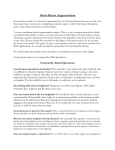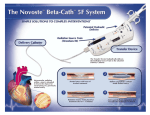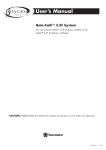Download Thrombosis Home Monitor Program
Transcript
Thrombosis Home Monitor Program Thrombosis Clinic, BC Children's Hospital 4480 Oak Street, Vancouver, BC V6H 3V4 604 875 2345 www.bcchildrens.ca What is a Blood Clot? When your blood changes from a liquid to a solid it forms a blood clot. A blood clot is like very thick blood. A blood clot is normally a good thing because it will stop the bleeding when you hurt yourself. A bad blood clot is when your body makes a clot when it does not need one. The bad clots usually form in the vessels that carry the blood back to the heart. These vessels are called veins (VAY-ns). Vessels that carry the blood away from your heart to your body are called arteries (AR-ter-EES). You body has its own “clot busters” (proteins) that work to break up the clot. What is a Blood Thinner? If you have a blood clot you may be given a blood thinner (an anticoagulant). The blood thinner stops the blood clot from getting bigger. It does not make the clot go away. A blood thinner does not really make your blood thin. It helps slow down the time it takes for your blood to clot. If you cut yourself when you are taking a blood thinner, it will take about 2 to 3 times longer for you to stop bleeding. What is the International Normalized Ratio (INR) Test? The International Normalized Ratio (INR) test tells us how long it takes for your blood to clot. The INR is based on how many seconds it takes your blood to clot or stop bleeding. This is known as the Prothrombin Time (PTT). The PTT is converted into an INR. An INR test is done by taking a small sample of blood and placing it on a test strip. The INR monitor will measure the PTT, which is then converted into the INR test result. A normal INR for someone who does not take a blood thinner is 0.9-1.2. - 1- How do Blood Thinners Affect the INR? The INR test tells us about the last 4-5 days of your blood thinner dosing. The INR test will see if your blood thinner is working well by telling us how long it takes for your blood to clot. This helps decide if the dose of the blood thinner is right for you. Since you are on a blood thinner (warfarin), you will be given a desired range for your INR. This is called the “therapeutic range.” It is ideal to keep your INR in the therapeutic range. Your therapeutic range may be: 1.5-2.0 2.0-2.5 2.0-3.0 2.5-3.5 What is Warfarin / Coumadin? Warfarin (WAR-fa-rin) is a type of blood thinner (an anticoagulant). It is also called Coumadin (Koo-ma-din). The INR will help tell us if your warfarin dose is right for you. Vitamin K counteracts (goes against) the effects of warfarin. Vitamin K is found in many foods, like green leafy vegetables. To learn more about Vitamin K and Warfarin, read the Warfarin pamphlet. You can find it under ‘W’ in the BC Children’s A-Z pamphlets at: www.bcchildrens.ca/KidsTeensFam/A-ZPamphlets In an emergency, if you are bleeding, you may be given a liquid form of vitamin K to counteract the anticoagulant effect of warfarin and help stop the bleeding. How Should You Take Warfarin? Warfarin should be taken by mouth in the evening or before bed. It should be taken around the same time every day. Every individual takes a different amount (dose) of warfarin. Your dose may change, depending on your INR test results. The warfarin pills are coloured. Each colour has a different amount of medicine in it. - 2- Keeping You Safe on Warfarin is a Balance If your blood has too much warfarin, it can make you bleed. If your blood does not have enough warfarin, you might develop a bad blood clot. The only way to be sure your blood has the right amount of warfarin is to check your INR. 1. It is VERY important that you check your INR when the Thrombosis Nurse Clinician tells you to. 2. Write the date for your next INR on your calendar, as well as the dose of warfarin that you are taking. 3. INR tests may be done more frequently when you first leave the hospital. After your INR stabilizes, you will not have to test your INR as often. 4. EVERY time you do an INR test, you should phone the Thrombosis Nurse Clinician with your INR test results. 5. If you are ill, it is important for you to check your INR more often. 6. Other medicines will change how warfarin works. Be sure to tell the Thrombosis Nurse Clinician if you start any new medicines or change the dose of medicines that you already take. 7. Try to eat a balanced diet. Keep your diet fairly constant, especially foods that contain vitamin K (e.g. broccoli, spinach, cucumber, and some cereals). This will help stabilize your INR. It is not necessary to take vitamin K supplements or to restrict the amount of vitamin K foods you eat. Important Things to Remember When Taking Warfarin! 1. Always wear your Medical I.D. bracelet. The bracelet should say that you are on an anticoagulant. The bracelet can be purchased at many pharmacies and you can engrave your specific information on it. 2. Be safe! NO contact sports. Be careful not to bump your head or get hit hard in the stomach. Be sure to wear a helmet when biking, boarding, skiing, etc. DO NOT binge drink. Alcohol will make your risk of bleeding even higher when you are taking warfarin. - 3- 3. If you forget a dose, don’t take 2 doses the next day to make up for it. 4. If you miss a dose, call your doctor or nurse and tell them. This may change the date you should do your INR test. 5. Don’t take Aspirin, ibuprofen, or other medicines without checking with your doctor or nurse first. Aspirin and ibuprofen are antiplatelet agents, which can increase your risk of bleeding. 6. Make sure you eat the same healthy foods you usually do. Your doctor or nurse will adjust your warfarin dose so that it is the right amount for you and the foods you usually eat. 7. If you choose to take multivitamins or supplements that contain vitamin K, it is important that you take them every day. Please tell the Thrombosis Nurse Clinician if you are taking any multivitamins or supplements. 8. If you cut yourself, put pressure on it for 10 minutes. If your nose starts to bleed, pinch it tightly and hold it for 10 minutes without letting go. If it is still bleeding after 10 minutes, hold your nose for another 10 minutes. If it is still bleeding, call your nurse or doctor. 9. When you are taking warfarin, you can still have your immunizations. Have the nurse that is giving you your immunization press firmly on the place where you had your injection for 5 minutes to prevent bleeding. 10. If you are having surgery, dental work, or any procedures that may cause bleeding, BE SURE to tell the Thrombosis Nurse Clinician. You may need to change your warfarin to another blood thinner so that your chance of bleeding is reduced. 11. Do not take warfarin if you might be pregnant. What is Point-Of-Care INR? It is important that you check to see if your blood thinner is working well and that you are within your target INR therapeutic range once you leave the hospital. Doing the INR at home is called ‘Point-of-Care’ (POC) Home INR Monitoring. Most families and children say the home monitor makes testing your blood much easier because you don’t have to go to the lab to have your blood checked. Instead, only a finger prick is needed to get the drop of blood for the INR test. By doing the test at home, you also get your test results quickly. - 4- The POC Home INR Monitor Program: How does it work? We will loan you a Coaguchek XS Home INR Monitor for 12 months. It is your responsibility to purchase the test strips. After 12 months, you may purchase a monitor from a pharmacy. Check with the Thrombosis Nurse Clinician on the cost of the monitor and strips. The monitor and strips are often not covered by extended insurance programs. For the Coaguchek XS Home INR Monitor, make sure to only use the Coaguchek XS INR test strips. Ensure the code number on the test strip bottle is the same as the code number on the chip that comes with the test strips. Each box of strips has its own chip. A credit card or void cheque will be required to secure the cost of the monitor. If the monitor is not returned after the 12 month loan period, you will be charged for the monitor. It is important that you are able to use the Home INR Monitor by yourself before you go home with it. The Thrombosis Nurse Clinician will teach you how to use the monitor. There will be a few teaching sessions. You must be available for all of the teaching. What you have to do... 1. Attend the teaching sessions with the Thrombosis Nurse Clinician. 2. We will test the POC Home INR Monitor against the clinic monitor to make sure your home monitor is working properly. The INR test results from the home monitor will be compared to the test results from the clinic monitor. This is called a quality check (Q.C.). The INR test results should be almost the same. 3. This test will be done when you first learn how to use the home monitor and then again at 6 months. If you chose to purchase a monitor after the 12 month loan period, we will Q.C. your monitor yearly. 4. Bring your monitor with you to every Thrombosis Clinic appointment. 5. Return the loaned monitor to BC Children’s Hospital after you have had it for 12 months. - 5- Using the POC Home INR Monitor Important Things to Know If your monitor is broken, damaged or does not work properly, call the Thrombosis Nurse Clinician or Roche (the Roche number can be found in the manual). Your monitor kit contains many small parts. This may include lancets, batteries, test strips, rubber ends, etc. These may be dangerous if swallowed. This can result in injury or death. Keep out of reach of small children. Do not use a cell phone or a cordless phone while you are doing a blood check on the monitor. How to use the POC Home INR Monitor 1. Find a place that is: Out of the sun. Flat. Clean and dry. About room temperature. 2. Wash your hands. DO NOT use alcohol swabs. They can elevate the INR artificially and give you an incorrect result. 3. Set out the items you will need to check your blood. 4. Prepare the disposable lancet: Twist the neck of the lancet to the correct setting (short, middle, or long). Your nurse will tell you which setting to use. Hold both ends of the lancet. Twist and pull at the same time to remove the stick-like cap. The lancet is now ready to use. - 6- 5. Press the blue button to turn on the monitor. A picture of the test strip will show up on the monitor’s screen. 6. Remove a test strip from the bottle and insert it into the monitor so that the red letters Coaguchek XS PT are facing up. Do not use strips that are: Past the expiration date printed on the strip bottle. Bent, punctured, cut, soiled or damaged in any way. 7. Watch the monitor screen. You will see a code number appear. - 7- If the number on the monitor screen and the code number on the test strip package are the same, then press the blue ‘M’ button. 8. The strip will now be warmed to a preset temperature. Pick which finger you want to poke to get your sample of blood. Do not pick your “pinky” finger or thumb. They will not bleed as well and may hurt when you poke them. - 8- 9. Hold the disposable lancet tightly, press down on the button and poke the finger you have chosen. Make sure to poke the side of your finger, not too close to the nail or the fingertip. This is the best place to get a drop of blood. Once you have pressed the blue ‘M’ button, the monitor will start to count down from 180. This means that you have 180 seconds or 3 minutes to put the drop of blood on the test strip. You must apply a drop of blood in this time or a 0000 error message will appear. 10. Gently press on the base of your finger and massage up towards the tip of your finger until a drop of blood appears. Do this several times until you have a big drop of blood that is hanging off your finger like a raindrop. Gently touch the drop of blood down on the “see through” area of the test strip, near the halfcircle. 11. Wrap a tissue loosely around your finger. Do not stop the bleeding until you are sure you have your INR test result. - 9- 12. The INR test results should appear after a few seconds. 13. If you get an ERROR message, you will need to start again by inserting a new test strip. You can use the same finger poke to get a new drop of blood as long as you get a fresh drop of blood within approximately 20 seconds. It is important that the drop of blood is fresh. What to do with INR Test Results Once you have your INR test results, call B.C. Children’s Hospital. Tuesday, Wednesday, and Thursday from 9am to 5pm: call the Thrombosis Nurse Clinician at 604-875-2345 extension 7058 Monday and Friday from 8am to 4pm: call the Hematology Nurse at 604-875-2345 extension 7060 Weekends and evenings: call the Hematologist on call at 604-875-2161 If the INR test result is inside the therapeutic range: Call us with the INR test result. You can leave a message. You don’t need to wait to hear from the clinic that day. Give medication as usual. If INR test result is outside therapeutic range: Call us with the result. You can leave a message. Don’t give the medication until you hear from us, as the dose may need to be adjusted. If you don’t hear from us by 5 pm that day call the Hematologist on call for direction at 604-875-2161. If you are unsure about your results or you think you may have taken too long to get a drop of blood on the strip, repeat the INR test to confirm the result. If you are on a weekly or monthly schedule, please try to do your INR Point of Care blood test on Tuesday Morning. This helps to ensure all results are dealt with in a timely manner. If your INR result is greater than 5.0, call us as soon as possible! You will not give the dose of warfarin that night. If you are bleeding and it won’t stop, come directly to the BC Children’s Hospital Emergency. - 10- Putting Your Equipment Away Safely It is important that you discard the single use lancet. Ask your pharmacy for a “sharps” container. This container allows you to discard the single use lancet in a safe way. Instead of the “sharps” container, you can use a glass jar with a lid. When the jar is full, bring it to the pharmacy for disposal. Cleaning Your POC Home INR Monitor 1. If your monitor becomes dirty, you can clean the surface of the monitor. Use mild soap and a damp cloth to wipe the surface of the monitor. 2. Be sure that your cloth is not too wet. 3. No water should enter the monitor. 4. If you have blood in or around the strip insertion area, you can clean the strip window. Pull up gently to lift the cover. Use a q-tip swab dipped in rubbing alcohol to gently clean the strip window. It is important to keep this window clean. When it has dirt on it, the monitor will not measure your blood correctly. Error Messages You may see an error message on your POC Home INR Monitor. It is important that you know what to do if you see one of these error messages. 1. Error 5, 6, or 7 There is not enough or too much blood on the test strip. Do the blood test again with a new test strip. 2. Flashing Test Strip Take out the test strip and reinsert. 3. Flashing Battery Symbol Change the batteries. 4. Flashing Temperature Symbol Monitor is too warm or too cold. Allow time for the monitor to adjust to room temperature. - 11- 5. Error 3 The test strip is beyond the expiry date. Requires new test strips. 6. Error 4 Test strip is unusable. Insert a new test strip. 7. Error 8 Diagnostic testing error. Call the Thrombosis Nurse Clinician and/or Roche. For more information on error messages, please see the Roche User’s Manual. Developed by the health professionals of the Thrombosis Clinic with assistance from the Learning & Development Department BCCH1544 ©2013 (6) BC Children’s Hospital - 12-




















